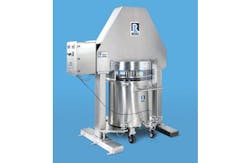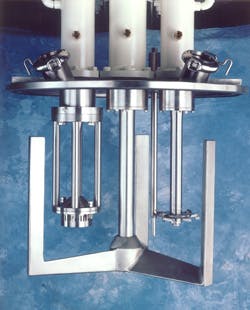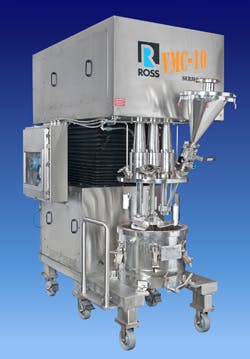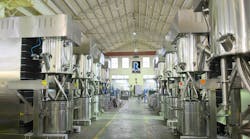Multishaft mixers are comprised of two or more independently driven agitators working in tandem. A low-speed anchor complements one or two stationary high shear devices, such as a saw-tooth disperser blade or a high shear mixer rotor/stator assembly. On its own, a disperser blade will produce acceptable flow patterns in batches up to around 50,000cP; the rotor/stator up to around 10,000cP.
Hence, for higher viscosities, there is a need for a supplemental agitator to improve bulk flow, deliver material to the high-speed devices and constantly remove product from the vessel walls for effective heat transfer.
The most common low speed agitator designs are the two-wing and three-wing anchor. For added efficiency, especially in terms of axial flow, a three-wing anchor can be modified to feature helical flights in between wings.
This style of mixer offers a number of advantages including:
Top-entry agitators. Unlike counter-rotating mixers with bottom-entering agitators, multi-shaft mixers offer better protection against contamination because there are no agitator seals submerged in the product zone. This also translates to easier clean-up and maintenance in general.
Broad viscosity range. In combination, the high-speed blades and anchor agitator of a multi-shaft mixer can handle a wide viscosity range: from water-like to up to a million centipoise. This attribute alone gives the mixer tremendous added value by eliminating transfer steps, pre-mixing or side-mixing operations. Users can prepare many products in the same mixer from start to finish. A batch may undergo many changes in viscosity, perhaps starting out as a thin liquid, gradually becoming more viscous with solid raw materials addition and temperature drop. Some applications will reach a viscosity peak mid-processing and finish as a low-viscosity fluid. Regardless, a well-designed and specified multi-shaft mixer delivers good turnover and superior heat transfer, imparts the required shear input and quickly deaerates batch product as necessary.
Processing flexibility. Having the ability to engage the agitators in many different combinations — in addition to keeping a tight control on temperature, pressure and other variables — enables operators to accomplish multiple processing objectives within a particular cycle or across many recipes. Dispersion of powders, emulsification, homogenization, entrainment of inert gases, acceleration of chemical reactions, removal of entrapped air — all of these and more are routinely accomplished in multi-agitator mixing systems.
Fast discharge and easy cleaning. When used for relatively flowable materials, multi-shaft mixers may be supplied with a dished-bottom vessel for complete discharge via gravity. But when dealing with non-flowing viscous mixtures, the mixer’s flat-bottomed vessel is used with a platen-style discharge system for fast and efficient product transfer. After the mixing cycle, the vessel is simply rolled to the discharge station and a precisely machined platen is lowered hydraulically into the batch. On its way down, an O-ring on the platen rides against the vessel sidewall, literally wiping it clean. In most cases, the discharge operation leaves only a very thin layer of product on the bottom to be cleaned out manually. Waste generation is truly minimal.
Agitator design varies from one manufacturer to another but essentially consists of at least one slow agitator and at least one high-speed blade. In general, agitator selection is based on viscosity and the level of shear required for a particular application. Viscosity of the starting liquid, maximum viscosity reached by the mixture during processing and final end product viscosity — if different from maximum viscosity — are all important considerations. Shearing mechanism is typically provided by a high-speed saw-tooth disperser blade, a rotor/stator assembly or a combination of these two.
Gas-purged shaft seals. For sanitary mixing purposes, agitator shafts are usually sealed at the cover with double mechanical seals lubricated with a compatible food-grade seal barrier fluid. Dry-running gas-purged sealing arrangements are also offered for highly sensitive formulations.
Vacuum design. Mixing under vacuum removes oxygen from the batch to prevent decomposition of sensitive ingredients or thwart unwanted chemical reactions and microbial growth. Minimizing oxygen content in beverages, for example, is a single important factor in maintaining consistent high quality during shelf life. Certain gels and pastes are mixed under vacuum to prevent defects in syringe filling. Even if current products don’t require or benefit from vacuum mixing, consider getting a vacuum-rated multi-shaft mixer for future needs.
Easy clean features. A polish of 150-grit or higher on all interior stainless steel surfaces helps prevents material buildup and promotes easy cleaning. Multi-shaft mixers can be cleaned in place by spraying cleaning solution via rotating nozzles strategically installed on the mixer cover. A flush-mounted discharge ball valve or flush-bottom diaphragm valve ensures there are no "dead zones" in the mix vessel where product can collect.
Powder injection. When dealing with solid raw materials that tend to dust, float or form tough agglomerates, consider sub-surface powder injection. One such technology is the solids/liquid injection manifold (SLIM) System offered on any Ross multi-shaft mixer with a rotor/stator component. The SLIM features a ported rotor that generates an intense vacuum for drawing solids right into the high shear zone of the mix chamber where they are instantly dispersed into the liquid. Solids are prevented from floating on the surface of the batch, accelerating wet-out and reducing the formation of agglomerates or "fish eyes." To minimize dusting, operators can simply draw powders straight from the bulk container using a hose and wand attachment. Otherwise, powders can be loaded into a feed hopper for fast induction.
Change-can vs. fixed-tank design. A change-can design multi-shaft mixer allows semi-continuous operation through use of multiple interchangeable vessels, including for mixing, discharging, cleaning and preparation. One vessel is under the mixer while another is in the discharge or clean-up stage, and still another would be the loading area being charged with raw materials for the next run. The fixed-tank design is more common on production multi-shaft mixers in the range of 500 gallons or larger.
Christine Banaszek is an application engineer at Charles Ross & Son Company, manufacturer of specialty mixing and blending equipment.





